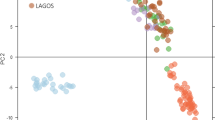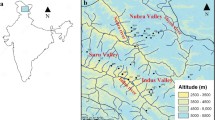Abstract
Gene sequences mediating sexual reproduction are more divergent within and between closely related species. Microsatellite or simple sequence repeat (SSR) markers are valuable molecular tools for analysis of genetic variability, phylogeny, and also for identifying sex at seedling stage in dioecious plant species. Calamus travancoricus Bedd. ex. Becc. and Calamus nagbettai R.R.Fernald & Dey are economically important rattan species. The dioecious nature of the Calamus spp. limits its breeding and cultivation. The sex of rattans can only be identified after attaining reproductive maturity which ranges from 5 to 15 years. A study was carried out in this background and 9 putative sex-specific PCR products were identified as sex markers for C. travancoricus and C. nagbettai and sequenced by Sanger method. The sequence homology search revealed occurrence of identical sequences in many plant species across different families indicating the conserved nature of the sequences. However, these sequences were not present in opposite sex in the studied species, indicating divergent evolution favoring sex determination. Annotation of these sequences revealed that most of these are mediating sexual reproduction by and large. An adequate sex ratio is to be maintained for these dioecious palms in natural habitat for producing offsprings having equal gene complements for continual evolution and sustainable utilization. Developing scientific management strategies and improved utilization of canes could help to generate employment locally and thus contribute to the socioeconomics sustainably.

Similar content being viewed by others
References
Baratakke RC, Patil CG (2009) Karyomorphological investigations in dioecious climber Momordica dioica Roxb. J Cytol Genet 11:91–96
Basu SK (1992) Rattans (Canes) in India. A monographic revision. Rattan Information Centre, Kepong, Kuala Lumpur
Belcher B, Rujehan NI, Achdiawan R (2004) Rattan, rubber, or oil palm: cultural and financial considerations for farmers in Kalimantan. Econ Bot 58, Supple: S77–S87, sp1
Bhowmick BK, Nanda S, Nayak S, Jha S, Joshi RK (2014) An APETALA3 MADS-box linked SCAR marker associated with male specific sex expression in Coccinia grandis (L). Voigt Sci Hort 176:85–90. https://doi.org/10.1016/j.scienta.2014.06.041
Charlesworth D (1993) Why are unisexual flowers associated with wind pollination and unspecialized pollinators? Am Nat 141(3):481–490. https://doi.org/10.1086/285485
Charlesworth D, Guttman DS (1999) The evolution of dioecy and plant sex chromosome systems. In: Ainsworth CC (ed) Sex determination in plants. BIOS ScientiWc Publishers, Oxford, pp 25–49
Cheng YJ, Meng HJ, Guo WW, Deng XX (2006) Universal chloroplast primer pairs for simple sequence repeat analysis in diverse genera of fruit crops. J Hortic Sci Biotechnol 81(1):132–138. https://doi.org/10.1080/14620316.2006.11512039
Choong CY, Wickneswari R (2016) Sexing in rattans. Malays Appl Biol 45:1–10
Danilova TV, Karlov GI (2006) Application of inter simple sequence repeat (ISSR) polymorphism for detection of sex-specific molecular markers in hop (Humulus lupulus L.) Euphytica 151(1):15–21. https://doi.org/10.1007/s10681-005-9020-4
Dransfield J (1979) A manual of the rattans of the Malay Peninsula. Malayan Forest Rec. no 29, p 270
Ehsanpour AA, Tavassoli M, Arab L (2008) Sex determination of Pistacia vera L. using ISSR markers. Malays Appl Biol 37:25–28
Garcia-Fernandez C, Casado MA (2005) Forest recovery in managed agroforestry systems: the case of benzoin and rattan gardens in Indonesia. For Ecol Manag 214(1–3):158–169. https://doi.org/10.1016/j.foreco.2005.04.013
Govaerts R, Dransfield J, Zona SF et al (2013) World checklist of Arecaceae. Facilitated by the Royal Botanic Gardens, Kew
Grewal A, Goyat S (2015) Marker assisted sex differentiation in dioecious plants. J Pharm Res 9:531–549
Hartwell JL (1970) Plants used against cancer. Lloydia 33:315–318
Harvey CF, Gill GP, Fraser LG, McNeilage MA (1997) Sex determination in Actinidia. 1. Sex-linked markers and progeny sex ratio in diploid A. chinensis. Sex Plant Reprod 10(3):149–154. https://doi.org/10.1007/s004970050082
Hosseinzadeh-Colagar A, Haghighatnia MJ, Amiri Z, Mohadjerani M, Tafrihi M (2016) Microsatellite (SSR) amplification by PCR usually led to polymorphic bands: evidence which shows replication slippage occurs in extend or nascent DNA strands. Mol Biol Res Commun 5(3):167–174
INBAR (2013) INBAR annual report 2013. International network for bamboo and rattan (INBAR)
Indira EP, Anto PV (2002) Karyotype analysis in Calamus palustris Griff. J Bamboo Ratt 1(3):199–203. https://doi.org/10.1163/156915902760184268
Jakse J, Stajner N, Kozjak P, Cerenak A, Javornik B (2008) Trinucleotide microsatellite repeat is tightly linked to male sex in hop (Humulus lupulus L.) Mol Breed 21(2):139–148. https://doi.org/10.1007/s11032-007-9114-x
Jiang C, Sink KC (1997) RAPD and SCAR markers linked to the sex expression locus M in asparagus. Euphytica 94(3):329–333. https://doi.org/10.1023/A:1002958007407
Khadke GN, Himabindu K, Ravishankar KV (2012) Development of SCAR marker for sex determination in dioecious betelvine (Piper betle L.) Curr Sci 103:712–716
Korpelainen H, Bisang I, Hedenäs L, Kolehmainen J (2008) The first sex-508 specific molecular marker discovered in the moss Pseudocalliergon trifarium. J Hered 99(6):581–587. https://doi.org/10.1093/jhered/esn036
Lakshmana AC (1993) Rattans of South India. Evergreen Publishers, Bangalore
Lemos EGM, Silva CLSP, Zaidan HA (2002) Identification of sex in Carica papaya L. using RAPD markers. Euphytica 127(2):179–184. https://doi.org/10.1023/A:1020269727772
Li M, Yang H, Li F, Yang F, Yin G, Gan S (2010) A male-specific SCAR marker in Calamus simplicifolius: a dioecious rattan species endemic to China. Mol Breed 25(3):549–551. https://doi.org/10.1007/s11032-009-9349-9
Márton ML, Fastner A, Uebler S, Dresselhaus T (2012) Overcoming hybridization barriers by the secretion of the maize pollen tube attractant ZmEA1 from Arabidopsis ovules. Curr Biol 22:1194–1198. doi: https://doi.org/10.1016/j.cub.2012.04.061
Maryam JMJ, Awan FS et al (2016) Development of molecular method for sex identification in date palm (Phoenix dactylifera L.) plantlets using novel sex-linked microsatellite markers. 3 Biotech 6(1):22. https://doi.org/10.1007/s13205-015-0321-6
Matsunaga S, Kawano S (2001) Sex determination by sex chromosomes in dioecious plants. Plant Biol 3(5):481–488. https://doi.org/10.1055/s-2001-17735
Milewicz M, Sawicki J (2013) Sex-linked markers in dioecious plants. Plant Omics 6:144–149
Ming R, Wang J, Moore PH, Paterson AH (2007) Sex chromosomes in flowering plants. Am J Bot 94(2):141–150. https://doi.org/10.3732/ajb.94.2.141
Mohan RHY, Tandon R (1997) Bamboo and rattans: from riches to rags. Proc Indian Natl Sci Acad 63:245–267
Muraleedharan PK, Jayashankar B, Rugmini P (1996) Some economic aspects of cane harvesting in Kerala. J non-timber For Prod 3:202–207
Nadarajah K, Choong CY, Leong SJ, Wickneswari R (2009) Functional prediction of Calamus manan inflorescence ESTs through motif detection. Biotechnology 8(3):329–342. https://doi.org/10.3923/biotech.2009.329.342
Nadot S, Alapetite E, Baker WJ, Tregear JW, Barfod AS (2016) The palm family (Arecaceae): a microcosm of sexual system evolution. Bot J Linn Soc 182(2):376–388. https://doi.org/10.1111/boj.12440
Nageswara Rao M, Ramesha BT, Ravikanth G et al (2007) Cross-species amplification of coconut micro-satellite markers in rattans. Silvae Genet 56:282
Nanda S, Kar B, Nayak S, Jha S, Joshi RK (2013) Development of an ISSR based STS markers for sex identification in pointed gourd (Trichosanthes dioica Roxb.) Sci Hort 150:11–15. https://doi.org/10.1016/j.scienta.2012.11.009
Ng CY, Wickneswari R, Choong CY (2014) Identification of floral genes for sex determination in Calamus palustris Griff. by using suppression subtractive hybridization. Genet Mol Res 13(3):6037–6049. https://doi.org/10.4238/2014.August.7.18
Paran I, Michelmore RW (1993) Development of reliable PCR-based markers linked to downy mildew resistance genes in lettuce. Theor Appl Genet 85(8):985–993. https://doi.org/10.1007/BF00215038
Parasnis AS, Ramakrishna W, Chowdari KV, Gupta VS, Ranjekar PK (1999) Microsatellite (GATA)n reveals sex-specific differences in papaya. Theor Appl Genet 99(6):1047–1052. https://doi.org/10.1007/s001220051413
Parrish TL, Koelewijn HP, van Dijk PJ (2004) Identification of a male-specific AFLP marker in a functionally dioecious fig, Ficus fulva Reinw. ex Bl. (Moraceae). Sex Plant Reprod 17(1):17–22. https://doi.org/10.1007/s00497-004-0208-x
Perera L, Russell JR, Provan J, Powell W (1999) Identification and characterisation of microsatellite loci in coconut (Cocos nucifera) and the analysis of coconut populations in Sri Lanka. Mol Ecol 8(2):344–346
Raja Barizan RS (1992) Phenology of rattans. In: Wan Mohd WR, Dransfield J, Manokaran N (eds) A guide to the cultivation of rattan. Malayan forest record no. 35. Forest Research Institute Malaysia, Kuala Lumpur, pp 39–46
Ravikanth G, Ganeshaiah KN, Uma Shaanker R, Shaanker RU (2001) Mapping genetic diversity of rattans in the Central Western Ghats: identification of hot-spots of variability for in-situ conservation. In: Uma Shaanker R, Ganeshaiah KN, Bawa KS (eds) Forest genetic resources: status, threats and conservation strategies. Science Publishers, Enfield, pp 69–83
Renner SS, Ricklefs RE (1995) Dioecy and its correlates in the flowering plants. Am J Bot 82(5):596–606. https://doi.org/10.2307/2445418
Renuka C (1992) Rattans of Western Ghats—a taxonomic manual. Kerala Forest Research Institute, Peechi, Thrissur
Sarmah P, Barua VJ, Nath J, Sarma RN, Kurian B, Hemanthkumar AS, Sabu KK (2016) ISSR and SSR markers reveal sex-specific DNA sequences in three Calamus species from India. Agrofor Syst 91(3):1–5. https://doi.org/10.1007/s10457-016-9952-9
Sarmah P, Sarma RN (2011) Identification of a DNA marker linked to sex determination in Calamus tenuis Roxb., an economically important rattan species in northeast India. Mol Breed 27(1):115–118. https://doi.org/10.1007/s11032-010-9510-5
Sinha P, Nanda S, Joshi RK, Panda PC (2017) Development of a sequence-tagged site (STS) marker for sex identification in the dioecious rattan species Calamus guruba Buch.-Ham. Mol Breed 37(3). https://doi.org/10.1007/s11032-017-0630-z
Song BK, Nadarajah K, Wickneswari R (2007) A non-redundant strategy for identification of a minimum tiling path BAC contig spanning approximately 390 kb of the QTL yld1.1 in Oryza rufipogon. Korean J Genet 29:447–458
Swanson WJ, Vacquier VD (2002) The rapid evolution of reproductive proteins. Nat Rev Genet 3(2):137–144. https://doi.org/10.1038/nrg733
Sztuba-Solinska J (2005) Molecular markers systems and their application in plant breeding. Kosmos 54:227–239
Takeuchi H, Higashiyama T (2012) A species-specific cluster of Defensin-like genes encodes diffusible pollen tube attractants in Arabidopsis. PLoS Biol 10(12):e1001449. https://doi.org/10.1371/journal.pbio.1001449
Terras FR, Schoofs HM, De Bolle MF, van Leuven F, Rees SB, Vanderleyden J, Cammue BP, Broekaert WF (1992) Analysis of two novel classes of plant antifungal proteins from radish (Raphanus sativus L.) seeds. J Biol Chem 267(22):15301–15309
Thomma BP, Cammue BP, Thevissen K (2002) Plant defensins. Planta 216(2):193–202. https://doi.org/10.1007/s00425-002-0902-6
UmaShankar R, Ganeshaiah K, Srinivasan K et al (2004) Bamboos and Rattans of the Western Ghats: Population Biology, Socio-economics and Conservation Strategies. Ashoka Trust for Research in Ecology and the Environment (ATREE), Bangalore
Vyskot B, Hobza R (2004) Gender in plants: sex chromosomes are emerging from the fog. Trends Genet 20(9):432–438. https://doi.org/10.1016/j.tig.2004.06.006
Wang K-L, Xie J, Zhang T, Gu Z-J (2005) A karyological study of four species in Calamus (Palmae: Calamoideae). Acta Bot Yunnan 27:87–91
Yang H, Gan S-M, Yin H-T, Xu H-C (2005) Identification of random amplified polymorphic DNA markers linked to sex determination in Calamus simplicifolius C. F Wei J Integr Plant Biol 47(10):1249–1253. https://doi.org/10.1111/j.1744-7909.2005.00113.x
Acknowledgements
The authors thankfully acknowledge the financial help received from the Kerala State Council for Science, Technology and Environment (KSCSTE), Thiruvananthapuram (order no. 234/KBC/2012/KSCSTE) for this work. We extend our sincere thanks to Director, JNTBGRI for providing necessary facilities. We also extend our special thanks to Kerala State Forest Department for granting permission to collect leaf samples of the rattan species from various forest regions (order no. WL 10-3053/2012). The authors express their gratitude to Mr. Shefeek S. for assistance during plant collection trips.
Author information
Authors and Affiliations
Corresponding author
Ethics declarations
Conflict of interest
The authors declare that they have no conflict of interest.
Data archiving statement
All the DNA sequences generated in the study were deposited in NCBI GenBank under accession numbers KX495760.1, KX495761.1, and KX495762.1 and submission ids MF686043 to MF686048.
Additional information
Communicated by W. Ratnam
Rights and permissions
About this article
Cite this article
Kurian, B., Hemanthakumar, A., Jacob, J. et al. Rapidly evolving sex-specific sequences in Calamus travancoricus Bedd. ex. Becc. and Calamus nagbettai R.R.Fernald & Dey. Tree Genetics & Genomes 14, 11 (2018). https://doi.org/10.1007/s11295-017-1220-2
Received:
Revised:
Accepted:
Published:
DOI: https://doi.org/10.1007/s11295-017-1220-2




